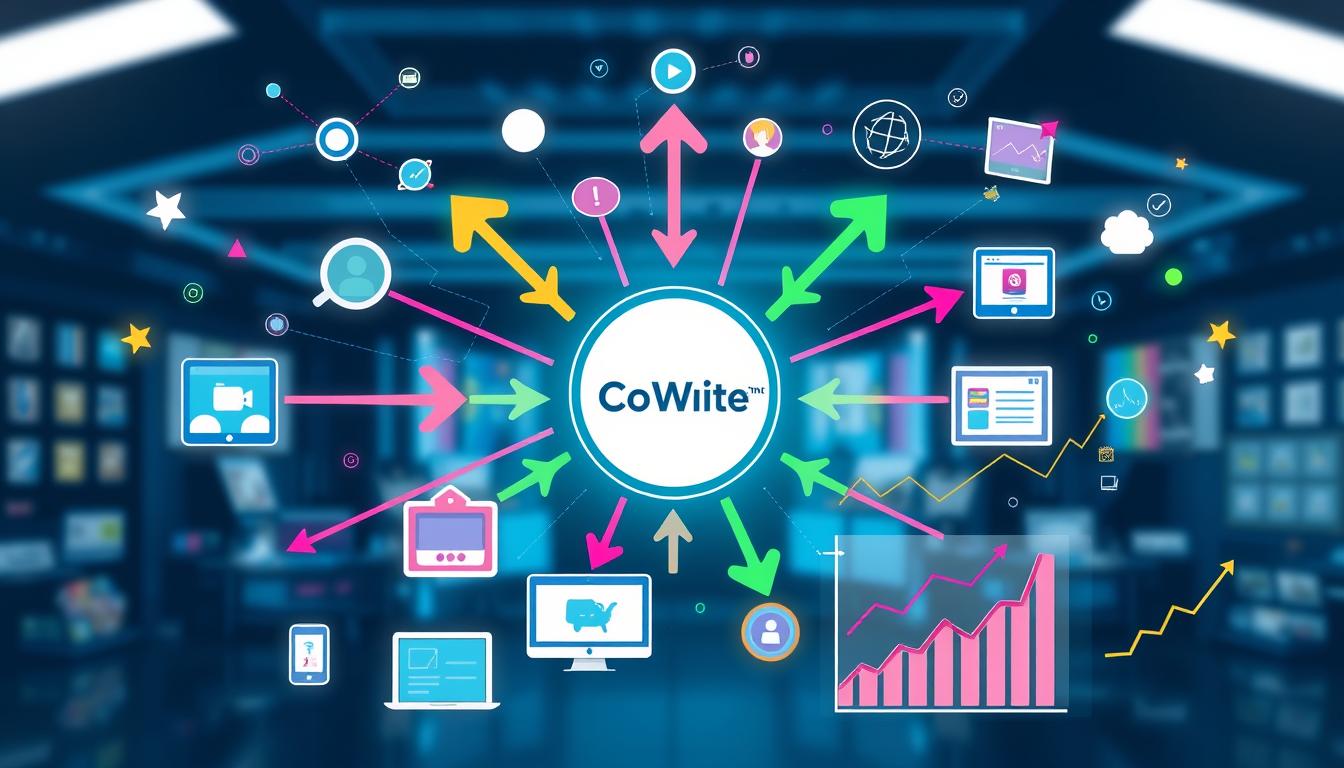Affiliate marketing has become a cornerstone of digital revenue strategies. With global spending projected to hit $12 billion by 2025, it’s clear this industry is here to stay. We’re here to break down everything you need to know to succeed in this dynamic field.
At its core, affiliate marketing is about partnerships. Affiliates earn commissions by promoting products or services through unique links. Platforms like Amazon Associates and Travelpayouts are prime examples of how this model works in real-world scenarios. These links are essential for tracking sales and ensuring affiliates get paid for their efforts.
This guide dives deep into the tools, tips, and trends shaping the industry. Whether you’re new to affiliate marketing or looking to refine your strategy, we’ve got you covered. From understanding commission structures to leveraging data-driven insights, we’ll help you navigate this competitive landscape.
Ready to take your affiliate marketing game to the next level? Let’s get started.
Key Takeaways
- Affiliate marketing is a performance-based strategy driving billions in revenue.
- Unique affiliate links are crucial for tracking and earning commissions.
- Platforms like Amazon Associates offer diverse opportunities for affiliates.
- Data-driven strategies are key to optimizing performance and ROI.
- Staying updated on industry trends ensures long-term success.
Introduction to Affiliate Marketing
Earning through affiliate links has become a popular online strategy. It’s a performance-based model where affiliates promote products or services and earn commissions for every sale made through their unique links. This simple yet effective approach has made affiliate marketing a go-to choice for many online entrepreneurs.
What Is Affiliate Marketing?
At its core, affiliate marketing involves three main players: the merchant, the affiliate, and the customer. The merchant provides the product or service, the affiliate promotes it, and the customer makes the purchase. Affiliate networks often act as intermediaries, connecting merchants with affiliates and managing the tracking process.
Unique affiliate links are the backbone of this system. These links track sales and ensure affiliates receive their commissions. For example, if you promote a product using your affiliate link and someone buys it, you earn a percentage of the sale. This process is seamless and automated, making it easy for beginners to get started.
Transparency is crucial in affiliate partnerships. Affiliates must disclose their relationships with merchants to maintain trust with their audience. Compliance with disclosure regulations, such as using “sponsored” or “nofollow” tags, is essential to avoid penalties and build credibility.
Affiliate marketing offers numerous benefits. It’s cost-effective, scalable, and allows you to earn passive income. Whether you’re a blogger, influencer, or website owner, joining an affiliate program can be a game-changer for your online revenue strategy.
The Ultimate Guide to Affiliate Marketing: Tools, Tips, and Trends
Social media has transformed how affiliate marketers connect with audiences. It’s no longer just about sharing links; it’s about building relationships and trust. In this guide, we’ll explore the tools, tips, and trends that can help you succeed in this competitive field.
Whether you’re just starting or looking to refine your strategy, this guide has something for everyone. We’ll cover everything from joining affiliate programs to advanced tactics like hybrid commission models and SEO best practices. Here’s what you’ll learn:
- Evolution of affiliate marketing: Understand how this industry has grown and what’s driving its success.
- Actionable tools and strategies: Discover resources that can help you grow your affiliate marketing business.
- Social media as a powerful channel: Learn how platforms like Instagram and TikTok can amplify your efforts.
- Content creation and SEO: Get tips on crafting engaging content and optimizing it for search engines.
- Conversion optimization: Explore techniques to turn clicks into sales.
This guide is designed for both beginners and seasoned affiliate marketers. We’ll provide actionable insights backed by real-world examples and trusted sources. Ready to take your affiliate marketing game to the next level? Let’s dive in.
The Evolution of the Affiliate Marketing Industry
From humble beginnings, affiliate marketing has evolved into a multi-billion-dollar industry. What started as simple referral programs has grown into a sophisticated ecosystem of digital strategies. This growth reflects advancements in technology and shifts in consumer behavior.
Early affiliate networks relied on basic tracking methods. Today, they use advanced tools to monitor clicks, conversions, and affiliate income. These tools ensure accurate tracking and fair compensation for affiliates.
Promoting product service offerings has become more effective with these advancements. Affiliates now use multi-channel approaches, combining social media, email marketing, and SEO. This shift has led to higher engagement and better results.
Technological innovations have played a key role. AI and automation tools now analyze data in real-time, providing actionable insights. These tools help affiliates optimize their campaigns and maximize earnings.
Changing customer behaviors have also shaped the industry. Consumers now prefer personalized recommendations. This trend has made unique affiliate strategies more valuable than ever.
Here’s a look at key milestones in the industry’s evolution:
| Year | Milestone | Impact |
|---|---|---|
| 1996 | Launch of Amazon Associates | Pioneered the affiliate marketing model |
| 2005 | Rise of social media | Expanded reach and engagement |
| 2015 | Advent of AI tools | Enhanced tracking and optimization |
| 2024 | Global industry value reaches $17 billion | Solidified affiliate marketing as a key revenue stream |
Success stories highlight the industry’s potential. For example, SharkNinja’s affiliate program saw a 30% increase in revenue after expanding its network. These examples inspire affiliates to innovate and grow.
Looking ahead, the industry continues to evolve. Trends like AI integration and influencer partnerships are shaping the future. By staying updated, affiliates can unlock new opportunities and boost their affiliate income.
How Affiliate Marketing Works: Key Players and Processes
Understanding the mechanics of affiliate marketing is essential for success. This process involves three main players: merchants, affiliates, and customers. Each plays a critical role in driving sales and earning commissions.

Merchants and Affiliates
Merchants are the backbone of affiliate programs. They supply products, create affiliate links, and provide marketing materials. Affiliates, on the other hand, use these resources to promote product offerings effectively.
A strong marketing strategy is key for affiliates. They craft content that resonates with their audience, whether through blogs, social media, or email campaigns. This collaboration benefits both parties, as merchants gain exposure while affiliates earn commissions.
The Customer Journey
The process begins when a customer clicks an affiliate link. Cookies track this interaction, ensuring the affiliate gets credit for the sale. From there, the customer navigates through the purchase process, often influenced by the affiliate’s recommendations.
Transparency is crucial. Affiliates must make sure they disclose their partnerships to maintain trust. This honesty not only builds credibility but also aligns with legal requirements.
“Affiliate marketing thrives on trust and strategic planning. Every click, every sale, and every commission is a result of a well-executed process.”
By understanding these roles and processes, you can optimize your affiliate efforts. Focus on clear communication, effective promotion, and ethical practices to maximize your success.
Joining Affiliate Networks and Programs
Choosing the right affiliate networks and programs is a critical step toward building a sustainable income stream. With so many options available, it’s essential to select platforms that align with your niche and goals. Let’s explore how to make the best choice and maximize your earnings.
Popular Affiliate Programs
Some of the most reputable marketing programs include Amazon Associates and Travelpayouts. Amazon Associates is a great starting point for beginners, offering a wide range of products to promote. Travelpayouts, on the other hand, specializes in travel-related offers, making it ideal for niche bloggers.
Joining an affiliate network can streamline your efforts. These platforms connect you with multiple merchants, saving time and expanding your earning potential. For example, AWIN operates in over 180 countries, providing access to thousands of advertisers.
Evaluating Commission Structures
When selecting a program, pay attention to commission rates and payment models. Some programs offer Pay-Per-Sale (PPS), while others use Pay-Per-Lead (PPL) or Pay-Per-Click (PPC). Choose a structure that aligns with your audience and content style.
It’s also important to consider cookie durations. Longer tracking periods, like 30 days, ensure you earn commissions even if the purchase happens later. This can significantly boost your earnings as a successful affiliate.
Success Factors for Affiliates
To thrive in affiliate marketing, focus on programs that match your niche. For instance, if you run a tech blog, promoting software or gadgets will resonate with your audience. Additionally, prioritize transparency by disclosing affiliate relationships to build trust.
Case studies show that affiliates who align their content with the right marketing program achieve better results. For example, Travelpayouts partners with over 480,000 bloggers, helping them earn through travel-related promotions.
By carefully selecting and joining the right affiliate network, you can unlock new opportunities and build a sustainable income stream. Start by evaluating your niche, audience, and goals to make informed decisions.
Setting the Foundations for Affiliate Marketing Success
Success in affiliate marketing begins with choosing the right niche. A well-defined niche aligns your marketing effort with both your interests and market demand. This focus helps you stand out in a competitive landscape.

Identifying Your Niche
To identify a profitable niche, start by exploring your passions. What topics excite you? Aligning your niche with your interests ensures long-term motivation. Next, analyze market demand using tools like Google Trends or keyword research platforms.
Here’s a simple process to find your niche:
- List your interests and expertise.
- Research trending topics in those areas.
- Evaluate competition and identify gaps.
A focused marketing effort increases your chances of success. For example, if you’re passionate about fitness, promoting workout gear or supplements can resonate with your audience. Many successful affiliates started affiliate marketing with this approach.
“Choosing the right niche is like planting a seed. With care and focus, it grows into a thriving affiliate business.”
Tracking performance is equally important. Use analytics tools to monitor how often users click affiliate links and convert. This data helps refine your strategy and maximize earnings.
Here’s a comparison of popular niches and their potential:
| Niche | Market Demand | Competition Level |
|---|---|---|
| Health & Fitness | High | Moderate |
| Technology | Very High | High |
| Travel | Moderate | Low |
By focusing on a niche, you can create tailored content that resonates with your audience. This approach not only boosts engagement but also increases the likelihood of users clicking affiliate links and making purchases.
Remember, many successful affiliates started affiliate marketing with a clear niche focus. By following these steps, you can set a strong foundation for your affiliate journey.
Keyword Research and SEO Best Practices for Affiliates
Effective keyword research and SEO practices are the backbone of sustainable affiliate success. By understanding how to optimize content and attract organic traffic, you can build a reliable stream of passive income. Let’s explore the strategies that make this possible.
Optimizing Your Content
Keyword research is the foundation of any successful SEO strategy. Tools like SEMrush and Google Keyword Planner help identify high-potential search terms. Focus on long-tail keywords, as they often have lower competition and higher conversion rates.
Once you’ve identified your keywords, integrate them naturally into your content. Place them in titles, headings, and meta descriptions to improve search engine visibility. Remember, readability is key—your content should flow seamlessly while incorporating targeted keywords.
Generating Organic Traffic
Organic traffic is essential for long-term success. By optimizing your content for search engines, you can attract visitors who are genuinely interested in your niche. This not only boosts engagement but also increases the likelihood of users clicking your affiliate links.
Regularly update your content to reflect changing trends and incorporate new keywords. Use analytics tools to track performance and refine your strategy. Over time, these efforts will contribute to a steady stream of passive income.
“SEO isn’t just about ranking higher—it’s about connecting with the right audience and driving meaningful results.”
Here are some practical tips to enhance your SEO efforts:
- Use tools like Google Trends to identify seasonal keywords.
- Analyze competitor keywords to uncover gaps in your strategy.
- Focus on both on-page and off-page optimization for comprehensive results.
By mastering these techniques, you can create content that ranks well, attracts organic traffic, and supports your affiliate goals. Start implementing these practices today to see measurable improvements in your performance.
Tools and Resources for Affiliate Marketers
Having the right tools can make or break your affiliate marketing efforts. From tracking performance to managing content, these resources streamline your workflow and maximize results. Let’s explore the essentials every marketer should have in their toolkit.

Essential Marketing Tools
Tracking performance is crucial for success. Tools like Google Analytics and Semrush provide detailed insights into clicks, conversions, and revenue. These platforms help you refine your strategy and focus on what works.
Content management is another key area. Platforms like ConvertKit and GetResponse simplify email campaigns and automation. They also offer analytics to measure engagement and optimize your content.
“The right tools not only save time but also provide actionable insights to grow your affiliate business.”
For link management, consider tools like Pretty Links or ThirstyAffiliates. These platforms help you create, track, and organize affiliate links efficiently. They also ensure your links are clean and professional.
Here’s a quick list of must-have tools:
- Tracking: Google Analytics, Semrush
- Content Management: ConvertKit, GetResponse
- Link Management: Pretty Links, ThirstyAffiliates
By leveraging these resources, you can enhance your affiliate marketing strategies and achieve better results. Start integrating these tools today to streamline your efforts and boost your earnings.
Leveraging Social Media for Increased Reach
Social media platforms are powerful tools for expanding affiliate reach. With billions of active users, platforms like Facebook, Instagram, and YouTube offer unparalleled opportunities to connect with your audience and drive conversions. Let’s explore how to make the most of these channels.
Engaging your audience is the first step. Create posts that resonate with their interests and needs. For example, Instagram’s visual format is perfect for showcasing products, while YouTube allows for in-depth tutorials and reviews. Tailor your content to each platform’s strengths.
Integrating affiliate links naturally is crucial. Avoid overly promotional posts. Instead, focus on providing value. Share tips, how-tos, or personal experiences that include your links. This approach builds trust and encourages clicks.
Case studies highlight the potential of social media. For instance, a travel blogger saw a 40% increase in affiliate sales by sharing destination guides on Instagram. Similarly, a tech reviewer boosted conversions by posting unboxing videos on YouTube.
“Social media isn’t just about posting—it’s about building relationships and trust with your audience.”
Here are some tips for creating shareable content:
- Use high-quality images and videos to grab attention.
- Incorporate trending hashtags to increase visibility.
- Engage with followers through comments and polls.
While social media offers immense potential, there are pitfalls to avoid. Overposting can annoy your audience, while failing to disclose affiliate relationships can damage credibility. Always be transparent and maintain a consistent posting schedule.
Here’s a comparison of popular platforms and their strengths:
| Platform | Strengths | Best For |
|---|---|---|
| Diverse user base | Broad audience engagement | |
| Visual content | Fashion, beauty, travel | |
| YouTube | Video tutorials | Tech, reviews, tutorials |
By leveraging social media effectively, you can amplify your affiliate program and achieve long-term success. Start implementing these strategies today to connect with your audience and drive meaningful results.
Crafting Content That Converts
Creating content that converts is the backbone of successful affiliate strategies. High-quality content not only engages readers but also drives them to take action. Whether it’s a product review or a how-to guide, your site should offer value that resonates with your audience.
To maximize your commission potential, focus on content that aligns with your niche. Tailored content builds trust and encourages users to click your affiliate links. Here’s how to create content that converts:
Engaging Content Creation
Start by understanding your audience’s needs. What problems are they trying to solve? Use this insight to craft content that provides solutions. For example, comprehensive product reviews or step-by-step tutorials can be highly effective.
Case studies are another powerful tool. They showcase real-world examples of how a product or service has helped others. This builds credibility and encourages conversions. Always aim for authenticity—your audience can tell when content feels forced.
“Great content doesn’t just inform—it inspires action and builds trust.”
Effective Promotion Techniques
Once you’ve created valuable content, it’s time to promote it. Share your posts on social media, email newsletters, and forums related to your niche. Engaging with your audience through comments and polls can also boost visibility.
Here’s a comparison of content types and their impact:
| Content Type | Engagement Level | Conversion Potential |
|---|---|---|
| Product Reviews | High | Very High |
| How-To Guides | Moderate | High |
| Case Studies | High | High |
By combining engaging content with strategic promotion, you can increase your commission opportunities. For more tips on optimizing your affiliate strategy, check out this comprehensive guide.
Affiliate Link Strategies and Tracking Techniques
Maximizing affiliate income requires precise tracking and strategic link placement. By understanding how to monitor and optimize your links, you can bridge the gap between clicks and conversions effectively.
Tracking Customer Actions
Tracking cookies are essential for monitoring customer behavior after they click an affiliate link. These cookies store data like click timestamps and referral sources, ensuring you get credit for the sale. Most cookies last between 7 to 30 days, giving customers time to make a purchase.
Advanced tools like Google Analytics and Semrush provide deeper insights. They track metrics such as click-through rates, conversion rates, and revenue generated. This data helps refine your strategy and focus on high-performing links.
Optimizing for Conversions
Placement plays a key role in conversion optimization. Test different positions for your links, such as within product reviews, call-to-action buttons, or sidebar banners. A/B testing can reveal which placements drive the most income.
Content quality also matters. Ensure your links are integrated naturally into valuable content. For example, a detailed how-to guide with embedded affiliate links can boost trust and encourage clicks.
“The right tracking tools and strategic placement can turn clicks into consistent revenue streams.”
Real-World Examples
One affiliate marketer increased their earnings by 40% after optimizing link placements in blog posts. Another saw a 25% boost in conversions by using exit pop-ups with real timers. These examples highlight the power of refining your strategy.
By leveraging tracking techniques and optimizing your links, you can maximize your affiliate income and achieve long-term success. Start implementing these tactics today to see measurable improvements in your performance.
Advanced Affiliate Marketing Strategies for Growth
Scaling your affiliate business requires innovative strategies beyond the basics. By adopting advanced techniques, you can diversify income streams and expand your reach. Let’s explore how hybrid commission models and multi-channel approaches can drive long-term growth.

Exploring Hybrid Commission Models
Hybrid models combine Pay-Per-Click (PPC), Pay-Per-Sale (PPS), and Pay-Per-Lead (PPL) structures. This approach allows you to earn from multiple actions, reducing reliance on a single income source. For example, you can earn from clicks while also benefiting from sales or leads generated through your platform.
Case studies show that affiliates using hybrid models achieve higher earnings. One marketer increased revenue by 30% by integrating PPC and PPS strategies. This flexibility ensures consistent income, even during market fluctuations.
Multi-Channel Approaches
Expanding your presence across multiple channels maximizes visibility. Combine social media, email marketing, and SEO to engage your target audience effectively. For instance, Instagram can drive traffic, while email campaigns nurture leads and boost conversions.
Here’s how to implement a multi-channel strategy:
- Use social media for initial engagement and brand awareness.
- Leverage email marketing to build relationships and promote offers.
- Optimize your website for SEO to attract organic traffic.
Audience Segmentation and Time Management
Advanced tools like Google Analytics and Semrush help segment your audience based on behavior and preferences. This allows you to tailor content and offers, increasing conversion rates. For example, you can create personalized campaigns for different segments, such as frequent buyers or first-time visitors.
Effective time management is equally important. Prioritize tasks that yield the highest returns, such as content creation and performance analysis. Tools like Trello or Asana can streamline your workflow and improve productivity.
“Innovation and testing are the cornerstones of advanced affiliate strategies. Continuously refine your approach to stay ahead in this competitive field.”
By embracing these advanced strategies, you can scale your affiliate business and achieve sustainable growth. For more insights, check out this comprehensive guide on optimizing your efforts.
Understanding Payment Structures and Maximizing Earnings
Understanding how affiliate payments work is key to maximizing your earnings. Payment models vary, and choosing the right one can significantly impact your income. Let’s break down the most common structures and how to make the most of them.
Affiliate programs typically use Pay-Per-Sale (PPS), Pay-Per-Click (PPC), or Pay-Per-Lead (PPL) models. Each has its benefits. PPS pays you when a sale is made through your link. PPC rewards you for clicks, while PPL compensates you for generating leads. Knowing which model aligns with your strategy is crucial.
To get started, evaluate programs based on their commission rates and cookie durations. Longer tracking periods, like 30 to 90 days, ensure you earn commissions even if the purchase happens later. This can boost your earnings significantly.
Here’s how to maximize your income:
- Choose programs with competitive commission rates.
- Focus on products or services that align with your niche.
- Use tracking tools to monitor performance and optimize your campaigns.
Real-world examples show the potential of strategic planning. For instance, affiliates using hybrid models, combining PPS and PPC, often see a 30% increase in earnings. This flexibility ensures consistent income, even during market fluctuations.
“The right payment model and tracking tools can turn clicks into a steady income stream.”
Managing your commissions effectively is equally important. Set up direct deposit methods and monitor your earnings regularly. Many programs have minimum payout thresholds, so plan accordingly to ensure timely payments.
By understanding payment structures and leveraging the right tools, you can maximize your affiliate earnings. This guide provides the foundation you need to succeed in this competitive field.
Legal, Ethical, and Trust-Building Considerations
Legal and ethical practices form the foundation of sustainable affiliate strategies. As a marketer, adhering to regulations and maintaining transparency is not just a requirement—it’s a way to build lasting trust with your audience.
The Federal Trade Commission (FTC) mandates clear disclosures for affiliate relationships. This means every blog post, video, or social media promotion must include a statement like, “I earn commissions from purchases made through these links.” Vague terms like “sponsored” are no longer sufficient.
Why Trust Matters
Trust is a tangible asset in affiliate marketing. When your audience knows you’re transparent, they’re more likely to engage with your content and click your links. A trustworthy website fosters loyalty, which translates into higher conversions and long-term success.
Ethical practices also protect your reputation. Misleading claims or undisclosed partnerships can lead to fines, legal actions, and even termination from affiliate programs. Staying compliant ensures you avoid these pitfalls.
Implementing Disclosure Best Practices
Here’s how to ensure your disclosures are effective:
- Place disclosures close to affiliate links for maximum visibility.
- Use clear, straightforward language to inform readers about potential commissions.
- Regularly audit your content to ensure compliance with updated regulations.
For example, Castlery, a digital-first furniture brand, saw a 12% increase in average order value after implementing compliance-focused strategies. This highlights the benefits of ethical practices.
Staying Updated with Legal Standards
Laws and regulations evolve, so it’s crucial to stay informed. The FTC’s 2025 guidelines will require even stricter disclosures, especially for short-form video content. AI tools like Shield can help monitor compliance in real-time.
Here’s a comparison of key legal requirements across regions:
| Region | Regulation | Key Requirement |
|---|---|---|
| United States | FTC Guidelines | Clear, close-to-link disclosures |
| European Union | GDPR | Consent before data collection |
| United Kingdom | ASA’s CAP Code | Label posts as advertisements |
By prioritizing legal compliance and ethical practices, you can build a trustworthy website and foster meaningful relationships with your audience. This approach not only protects your business but also drives sustainable growth.
Avoiding Common Pitfalls in Affiliate Marketing
Navigating the affiliate landscape requires awareness of common mistakes that can hinder growth. Even seasoned marketers can fall into traps that limit their potential. By understanding these pitfalls, you can build a more resilient business and achieve long-term success.
Mistakes to Avoid
One of the most frequent errors is poor link placement. Affiliates often bury links in irrelevant content, reducing their effectiveness. Instead, integrate links naturally into valuable posts, such as product reviews or how-to guides. This approach increases the likelihood of clicks and conversions.
Neglecting SEO is another common oversight. Without proper optimization, your content may not rank well, limiting visibility. Focus on keyword research, meta descriptions, and mobile-friendly designs to attract organic traffic. Regular updates ensure your content stays relevant.
Over-reliance on a single affiliate program can also be risky. Diversify your income streams by joining multiple programs that align with your niche. This strategy minimizes dependency on one source and boosts overall earnings.
“Success in affiliate marketing comes from learning from mistakes and refining your approach continuously.”
Refining Your Strategy
Regular audits are essential for identifying areas of improvement. Analyze metrics like click-through rates and conversions to understand what’s working. Use tools like Google Analytics to track performance and adjust your marketing business accordingly.
Financial mistakes, such as unrealistic expectations, can also derail your efforts. Focus on steady growth rather than quick wins. Invest time in building trust with your audience, as this leads to higher engagement and loyalty.
Here’s a quick checklist to avoid common pitfalls:
- Optimize link placement for maximum visibility.
- Prioritize SEO to drive organic traffic.
- Diversify your affiliate programs for stability.
- Conduct regular audits to refine your strategy.
By addressing these challenges, you can create a more sustainable effort and achieve your affiliate goals. Learn from mistakes, adapt your approach, and stay committed to growth.
Conclusion
Building a successful affiliate strategy requires dedication, strategic planning, and a focus on trust. Throughout this guide, we’ve explored essential tools, actionable tips, and industry trends to help you thrive. Now, it’s time to take those insights and apply them confidently.
Start by joining reputable networks and integrating affiliate links into your media channels. Focus on creating quality content that resonates with your audience, ensuring transparency in every promotion. Ethical practices and consistent effort are key to building lasting relationships and maximizing earnings.
Remember, affiliate success is a journey. Continuously test strategies, refine your approach, and stay updated on industry changes. By prioritizing trust and delivering value, you’ll unlock long-term growth and opportunities.
Ready to take the next step? Revisit this guide for updates and dive deeper into the strategies that work best for you. Your affiliate journey starts now!



